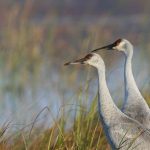Get a daily rundown of the top stories on Urban Milwaukee
Urban Almanac Oct 09
A Sensory Guide to Savor the Fall.
Tim Vargo, Manager of Research and Citizen Science. UEC
Regardless of your feelings on the subject, the inevitable is occurring. Summer is morphing into fall. I’d be willing to bet that half of you welcome the return of cool, crisp air and the coming brilliance of colors to the landscape while the other half of you lament the loss of summer heat and are bracing for the frigid winter and the loss of daylight.
Although the answer is obvious, the curious naturalist asks: How do we know that it’s autumn? And the naturalist in me says – go outside and use your senses.
There is plenty to see. Late wildflowers such as New England Aster turn a browning prairie into a palette of hues from pink to purple to white. All these shades come from a single species, like a crowd of human beings displaying different shades of hair, skin and eye color. Canada Goldenrod also lingers into fall, and if you look closely at the stem you may find a growth the shape of a ping-pong ball. This is the ingenious work of the goldenrod gall fly larva, whose saliva causes plant tissue to grow irregularly, like a scab or a tumor. The growth then becomes a cozy home for the larva during brutal winter conditions. The list of late-flying butterflies reads like a Victorian play, as you may glimpse a Monarch, a Dainty Sulfur, a Regal Fritillary or a Red Admiral, though the Frosted Elfin, the Olympia Marble, and the Persius Duskywing have long since disappeared from the landscape.
Autumn also brings plenty to the olfactory palate. My favorite fall scent is the distinct smell of decaying leaves in a forest, but a closer examination reveals a veritable scratch-and-sniff book of fauna. Crush the leaves of the aforementioned New England Aster and you may smell turpentine. Do the same for the wild bergamot seed heads (pizza), lavender hyssop leaves (anise), and sweet cicely (licorice). Scratch at the root of Queen Anne’s Lace for a refreshing carrot scent. Or follow the advice of Dan Graves, Environmental Educator at the Urban Ecology Center, who says the pale purple coneflower has a sweetly wild scent, but to unlock it you must first rub the oil off the seed head and onto your fingers.
Good smells often are a prelude to good meals, and the bounty of fall’s harvest is in a class of its own. Your hard work in the garden now yields potatoes, carrots, onions, squash and pumpkins. Take the Queen Anne’s Lace you just scratched and look for a good recipe for the root, the flower cluster and the seeds (CAUTION: Before eating wild plants, be sure you’ve identified them correctly, as some can make you very ill). It may not be too late to harvest blackberries, currants, cherries, plums or apples while you’re at it. And if you’re really adventurous you can turn the berries of staghorn sumac into a cool, refreshing sumac-ade drink.
Next up is the sense of touch — one of the lesser-used methods of monitoring the changing seasons. But we can definitely feel the cooler air on our skin, at least the parts that aren’t covered with jackets and windbreakers. You may also notice the decreased assault on your skin by biting flies and mosquitoes.
As fall progresses, the most distinct sound is the crunching of dried leaves under foot, or under body as the case may be with a newly raked pile in your backyard. Kim Forbeck, Land Steward at the Urban Ecology Center offers additional opportunities to hear fall’s natural symphony, but it takes a little work. The instruments include prairie dock and baptisia, and the maestro is the wind. If you listen closely, you will hear a distinct rustling with the dried leaves of prairie dock or a rattling in the case of the baptisia seedpods. However, not all of fall’s musicians are practiced professionals. In stark contrast to the bright, musical birds migrating in the spring, fall migrants include many recently-born amateurs, dull in color and in sound. This is a great time to listen for birds practicing their calls (and often failing miserably). The dissonant, unfamiliar, and unsure cacophony of the practicing white-throated sparrow may bring a puzzled look or a giggle to the human birder, but after a winter-time of practice it will resonate in the spring loudly and proudly: “Oh Sweet Canada, Canada, Canada!”

Monarch butterflies migrate south in the fall. We should at least head outside. iStock photo.
By Tim Vargo
Regardless of your feelings on the subject, the inevitable is occurring. Summer is morphing into fall. I’d be willing to bet that half of you welcome the return of cool, crisp air and the coming brilliance of colors to the landscape while the other half of you lament the loss of summer heat and are bracing for the frigid winter and the loss of daylight.
Although the answer is obvious, the curious naturalist asks: How do we know that it’s autumn? And the naturalist in me says — go outside and use your senses.
There is plenty to see. Late wildflowers such as New England Aster turn a browning prairie into a palette of hues from pink to purple to white. All these shades come from a single species, like a crowd of human beings displaying different shades of hair, skin and eye color. Canada Goldenrod also lingers into fall, and if you look closely at the stem you may find a growth the shape of a ping-pong ball. This is the ingenious work of the goldenrod gall fly larva, whose saliva causes plant tissue to grow irregularly, like a scab or a tumor. The growth then becomes a cozy home for the larva during brutal winter conditions. The list of late-flying butterflies reads like a Victorian play, as you may glimpse a Monarch, a Dainty Sulfur, a Regal Fritillary or a Red Admiral, though the Frosted Elfin, the Olympia Marble, and the Persius Duskywing have long since disappeared from the landscape.
Autumn also brings plenty to the olfactory palate. My favorite fall scent is the distinct smell of decaying leaves in a forest, but a closer examination reveals a veritable scratch-and-sniff book of fauna. Crush the leaves of the aforementioned New England Aster and you may smell turpentine. Do the same for the wild bergamot seed heads (pizza), lavender hyssop leaves (anise), and sweet cicely (licorice). Scratch at the root of Queen Anne’s Lace for a refreshing carrot scent. Or follow the advice of Dan Graves, Environmental Educator at the Urban Ecology Center, who says the pale purple coneflower has a sweetly wild scent, but to unlock it you must first rub the oil off the seed head and onto your fingers.
Good smells often are a prelude to good meals, and the bounty of fall’s harvest is in a class of its own. Your hard work in the garden now yields potatoes, carrots, onions, squash and pumpkins. Take the Queen Anne’s Lace you just scratched and look for a good recipe for the root, the flower cluster and the seeds (CAUTION: Before eating wild plants, be sure you’ve identified them correctly, as some can make you very ill). It may not be too late to harvest blackberries, currants, cherries, plums or apples while you’re at it. And if you’re really adventurous you can turn the berries of staghorn sumac into a cool, refreshing sumac-ade drink.
Next up is the sense of touch — one of the lesser-used methods of monitoring the changing seasons. But we can definitely feel the cooler air on our skin, at least the parts that aren’t covered with jackets and windbreakers. You may also notice the decreased assault on your skin by biting flies and mosquitoes.
As fall progresses, the most distinct sound is the crunching of dried leaves under foot, or under body as the case may be with a newly raked pile in your backyard. Kim Forbeck, Land Steward at the Urban Ecology Center offers additional opportunities to hear fall’s natural symphony, but it takes a little work. The instruments include prairie dock and baptisia, and the maestro is the wind. If you listen closely, you will hear a distinct rustling with the dried leaves of prairie dock or a rattling in the case of the baptisia seedpods. However, not all of fall’s musicians are practiced professionals.
In stark contrast to the bright, musical birds migrating in the spring, fall migrants include many recently-born amateurs, dull in color and in sound. This is a great time to listen for birds practicing their calls (and often failing miserably). The dissonant, unfamiliar, and unsure cacophony of the practicing white-throated sparrow may bring a puzzled look or a giggle to the human birder, but after a winter-time of practice it will resonate in the spring loudly and proudly: “Oh Sweet Canada, Canada, Canada!”






















